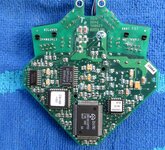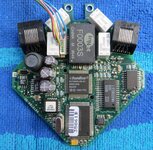tashtari
PIC Whisperer
So my objective in starting this thread is to fork from this one in asking the question of how to do LocalTalk faster.
I know there were a handful of schemes for LocalTalk-but-faster back in the day, and I'd love to know more about them. I know the SCC can be switched into a mode where an external, faster-than-230.4-kHz clock is provided over the GPi pin, and if there's software out there that simply enables that mode, I'd like to play with it and see what kinds of bitrates I can get out of a PIC with some clever firmware. I know the Farallon EtherWave was one such scheme - though according to @dougg3 's research, it appears to do more than just switch the SCC into external-clock-on-GPi mode, so it may not be suitable. Are there others? Is there a way to switch on the external-clock-on-GPi mode by patching LTLK resources, and if so, is that enough to take care of the problem of the Mac being able to load/unload the SCC fast enough, or is further hackery necessary?
My interest here is in creating a faster TashTalk-like device to provide connectivity to Ethernet-less macs. The limits of its current capabilities are the stock 230.4 kHz speed, which provides maximum compatibility, but unimpressive throughput. My thought is that if it's possible to provide the clock externally and the TashTalk-like device is the only device connected, it can pulse the clock whenever it's good and ready to receive a bit, potentially allowing for greater throughput as it doesn't have to worry about recovering the clock from somewhere else.
What do folks think?
I know there were a handful of schemes for LocalTalk-but-faster back in the day, and I'd love to know more about them. I know the SCC can be switched into a mode where an external, faster-than-230.4-kHz clock is provided over the GPi pin, and if there's software out there that simply enables that mode, I'd like to play with it and see what kinds of bitrates I can get out of a PIC with some clever firmware. I know the Farallon EtherWave was one such scheme - though according to @dougg3 's research, it appears to do more than just switch the SCC into external-clock-on-GPi mode, so it may not be suitable. Are there others? Is there a way to switch on the external-clock-on-GPi mode by patching LTLK resources, and if so, is that enough to take care of the problem of the Mac being able to load/unload the SCC fast enough, or is further hackery necessary?
My interest here is in creating a faster TashTalk-like device to provide connectivity to Ethernet-less macs. The limits of its current capabilities are the stock 230.4 kHz speed, which provides maximum compatibility, but unimpressive throughput. My thought is that if it's possible to provide the clock externally and the TashTalk-like device is the only device connected, it can pulse the clock whenever it's good and ready to receive a bit, potentially allowing for greater throughput as it doesn't have to worry about recovering the clock from somewhere else.
What do folks think?


